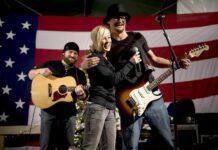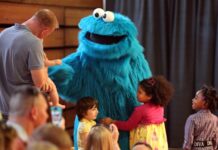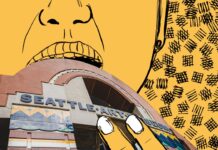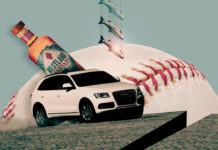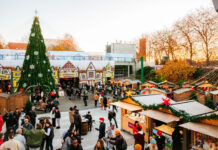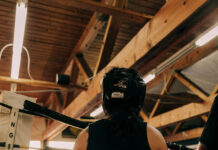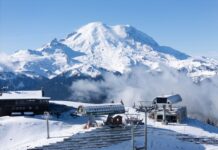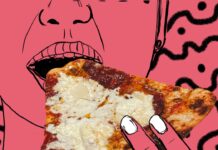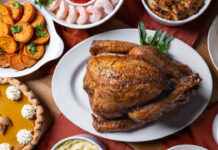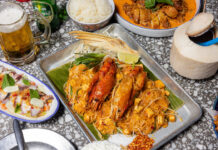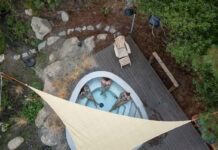Seattle Art Museum’s New Restaurant and More Food News
Hungry for news? Welcome to our Friday Feed, where we run through all the local food and restaurant news this week—and maybe help you figure out where to eat this weekend.
Girl Eating Porridge, an 1874 painting by William-Adolphe Bouguereau, part of the Farm to Table exhibit now on display at the Seattle Art Museum.
Seattle Art Museum Restaurant Gets a New Exhibit
Market, the restaurant inside the Seattle Art Museum, will close at the end of this year. Edmonds-based Feedme Hospitality Group opened the outpost of its casual seafood spot in 2021, bringing the much-hyped lobster rolls to downtown. Now, reports Puget Sound Business Journal, Feedme will swap it out for an outlet of its full-service fusion restaurant, Bar Dojo, expected to open in the spring. Anyone planning to get one last meal in at Market can work up an appetite at the museum’s current exhibit, Farm to Table: Art, Food, and Identity in the Age of Impressionism.
Running Dry
On November 30, Pike Brewing will close its Pike Place Market location and, with it, an era. Charles and Rose Ann Finkel founded Pike Brewing at the dawn of the craft brewery age, opening in 1989 and moving to the current location in Pike Place Market in 1996. Rose Ann passed away in 2020, and Charles sold the business to Seattle Hospitality Group. As Washington Beer Blog notes, SHG bought Fremont Brewing Company in 2024, and streamlined production by brewing Pike at Fremont, which it will continue to do.
Yes on Yemeni
One year ago, there were zero Yemeni restaurants in Seattle; now we are on the cusp of a third opening. Following in the footsteps of Renton’s Café Yemen and Kent’s Taste of Yemen will be Lynnwood’s the Yemeni House.
Smoke on the Water
Another week, another fire; this time it was Greenlake Bar & Grill going up in flames in the early morning, due to a gas leak, per the fire department. The restaurant left the Neighborhood Grills group this summer, and the new management hasn’t commented on the restaurant’s status or plans for recovery.
Adiós, Pablo
The Leschi location of Heavy Restaurant Group’s Pablo y Pablo closed this week, saying, “It has been very slow throughout the fall and would likely remain that way in the winter and early spring.” The Wallingford location remains open.
Sea Creature Watch
Neighborhood blog Capitol Hill Seattle is keeping a close watch on the former Bateau–General Porpoise–Boat Bar block and reports that…we’re still waiting. The retooled Bateau (and whatever else might be happening) is taking a backseat to the Pioneer Square projects and won’t open until at least February.
HomeGrown, Re-Grown?
The local sandwich shop that grew to a dozen locations before shuttering 10 of them and laying off more than 150 people seemed to be completely at the end earlier this month when the final two stores closed. A notice on the downtown location door said the company owed nearly a half-million dollars in back taxes. Now, just a few weeks later, Puget Sound Business Journal reports the store is back in business. But that was about all the paper could figure out, noting the company didn’t answer requests for comment and saying, “It's unclear how the struggling HomeGrown survived this latest setback.”
Oh, BTW, here’s what you missed last time.
Weird Seattle News of Late
Falling Fish
An osprey in British Columbia dropped a fish it had caught onto a power line, starting a small wildfire in the town of Ashcroft. Locals might remember that a similar incident closer to home in 2016 caused a power outage in South Seattle. Or more recently, the time this summer when a salmon fell from the sky and landed in T-Mobile Park, nearly hitting a camera operator.
Big Dumping
You know what was more likely to hit you in the head at a Mariners game this year? A Cal Raleigh home run ball. You probably didn’t miss this, but it’s worth repeating anyway because it’s as mind-boggling as any news to come out of Seattle in a long time. The man known as the Big Dumper hit a historic 60 home runs in the 2025 regular season—28 of them at T-Mobile.
Heist on Ice
More than 12,000 bottles of whiskey were stolen from Westland Distillery’s Burlington warehouse, the company told The Seattle Times. A truck driver pulled into the loading dock, presented paperwork that had been provided by a freight carrier contracted with Westland, then disappeared. Skagit County sheriff’s deputies are investigating, but as of press time the search for the missing whiskey is on the rocks.
A Bridge Too Far
A driver fleeing police in Eastlake found a unique means of escape: The evader rammed through a barricade and jumped a stolen car over an open span in the University Bridge, which was at the time lowering back into position after having opened for a boat. The action-movie stunt worked. The car was found abandoned nearby with significant damage, but the driver has yet to be located. Maybe they’re off drinking Westland whiskey somewhere.
Fall 2025
Singular Sensation
Jeopardy! host (and Seattleite) Ken Jennings got to remind America about the proper spelling of one of our local landmarks when a contestant wrongly answered “What is Pike’s Place Market?” on the game show. “We are sticklers in Seattle—it’s Pike Place. No s,” Jennings said, docking the contestant $1,000. Good thing there weren’t any clues about Nordstrom’s.
Water Ways
Forget hydroplanes—what about hydrofoils? According to The Seattle Times, multiple ventures are underway that would revive Seattle’s old mosquito fleet for a new generation. Kitsap Transit is developing its own electric foil ferry program for regional passengers. And Northern Ireland–based Artemis Technologies is already testing out an electric ferry that rides above the water, making for smoother passage around the Puget Sound.
Hive Mind
It’s bad enough when a semitruck crashes, causing damage and backups even when nobody gets hurt. But it especially stings when that semitruck is transporting 70,000 pounds of pollinator hives and honeybees. Yet that’s exactly what happened near Bellingham, allowing 14 million bees to escape and prompting a frantic effort by local sheriff’s deputies and master beekeepers to reunite as many as possible with their queens.
Walk This Way
It feels like Amazon is everywhere these days. You can’t walk down the street without bumping into a Rivian van filled with individually packaged consumer goods. Or surf the web without landing on a site hosted by Amazon Web Services. Or cross the street in South Lake Union without hearing Jeff Bezos talking to you through a crosswalk button. Wait, what? Yep. Several crosswalk buttons in town were hacked to play a message from a voice sounding suspiciously like Bezos’s imploring pedestrians with a message that may be near to his heart: “Please don’t tax the rich.”
Summer 2025
A Hard-boiled Crime
The avian flu has our national egg supply dwindling and even has local thieves thinking outside the, um, shell. Two miscreants in a white van broke into West Seattle’s Luna Park Cafe and made off with more than 500 eggs, plus additional ingredients from the restaurant’s walk-in. Owner Heong Park told Fox 13 that he was able to interrupt the heist after he got a call from a landlord and still open for breakfast that day after desperately sourcing replacement eggs.
Sign of the Times
Even free speech has a price. The parcel of land in Lewis County that includes the infamous Uncle Sam sign known for its provocative conservative messages along I-5 has been listed for $2.5 million. The sign currently reads “How many Americans will we leave behind in Ukraine” to southbound drivers and “No one died in WW2 so you could show papers to buy food” to northbound drivers. Maybe the next owner can use the billboard to promote the Cascadian independence movement.
Nothing Slow Can Stay
Elsewhere along I-5, after more than a year WSDOT crews finally removed a giant stuffed sloth that had been perched on a tree overlooking the interstate near Lake Samish. The sloth had become a subject of fascination to Reddit users in Bellingham, who dubbed him Slothy. “Slothy DOES remind us that it’s important to slow down,” WSDOT wrote on Facebook. But the agency said he also caused a dangerous distraction to drivers. No word on where the eight-foot mammal is living now.
Spring 2025
The Point of No Return
One of the perks of being an REI co-op member is the store’s generous return policy. If you don’t like a water bottle, or a jacket, or a pair of hiking boots, you have 365 days to bring it back—or at least most of you do. The retailer recently sent notice out to a small fraction of its members (less than 0.02 percent) who, REI says, abused the company’s generosity, returning the vast majority of their purchases, often after having used them. The message? No more returns for you.
He Walked in Beauty
Lord Byron, a Capitol Hill cat who became internet famous after its owners created a website where residents could document seeing him around the neighborhood, has died. He was a beloved cat who, boasting an AirTag tracker on his collar as he wandered his domain, endeared himself to locals, often hung out in random businesses, and accrued thousands of admirers on Facebook. May he rest in peace.
We Got Him This Time
An outbuilding in rural North Carolina. An old parachute that fits the description. A family with decades of suspicion. Could these be the clues that finally lead investigators to confirm the identity of iconic hijacker D. B. Cooper? The children of Richard Floyd McCoy II believe so, and claim their late father, who pulled off a similar heist in Utah five months after Cooper jumped out of that plane in 1971, was the man America has spent decades looking for. Of course, the FBI doesn’t seem think so.…
Mergers and Acquisitions
We’re used to hearing about grocery chains and telecom companies merging—not institutions of higher learning. But that’s exactly what’s happening as Cornish College of the Arts and Seattle University announced a plan to meld into a single institution. The smushing together comes at a time when private universities across the country are struggling with low enrollment and financial duress. This is probably a better fit than, say, Bastyr and Seattle Pacific Universities would be, but still weird.
Winter 2024
Bird Watching
When the Storm selected Sue Bird with the first pick of the 2002 WNBA draft, expectations were high. Two decades later, Bird retired as a five-time gold medalist, four-time league champion, and the kind of Seattle icon kids and adults admire equally. Now, she’s also the kind of icon who gets placed under the tree as a Christmas gift. The “Barbie Sue Bird Inspiring Women™ Doll” features Bird rocking not Storm colors, but a red, white, and blue jersey with her iconic number 10, and includes a little basketball, too.
Your Friendly Neighborhood Kinkajou
Drivers stopping for a breather at a rest area near Yakima on Interstate 82 were treated to a rare sight recently—a small, raccoon-like creature with sharp teeth, a long tail, and big round eyes clinging to a signpost. The animal turned out to be a kinkajou—a tropical rainforest mammal whose habitat stretches from Mexico to Brazil. How it ended up in an arid valley in Central Washington remains a mystery. But it was rescued by the Department of Fish and Wildlife and sent to the Point Defiance Zoo and Aquarium in Tacoma for care.
Tower Time
For a long time, the most iconic building in Seattle wasn’t the Space Needle—it was the Smith Tower, once the tallest building on the West Coast, with its pyramid pointing up to the sky. Since its construction in 1914, the skyscraper has lived many lives. For two decades, it was owned by local restaurateur Ivar Haglund, then by Samis—the foundation left behind by the eccentric Pioneer Square landlord Sam Israel. Now it has been purchased by a group of investors led by holding company GT Capital. No word yet on what they have planned for the penthouse.
Fall 2024
Twice Is Nice
We’ve been playing baseball or some form of it for more than 150 years. And yet the sport will always give you something you’ve never seen before. Case in point: Mariners fan Josh George caught a foul popup from third baseman Josh Rojas in the first inning of a home game against the Royals. Then, on the very next pitch, George got another foul popup off the bat of Rojas. The next day, the Mariners invited the lucky fan out to throw not one, but two ceremonial first pitches.
Ramps to Nowhere No More
For decades, foolish Seattleites have jumped off the “ramps to nowhere” at the Washington Park Arboretum and into the murky waters below. The ramps were a remnant of a north-south freeway project that was halted by community activists in the ’60s and ’70s. And now, finally, they have been removed: casualties of the 520 bridge replacement. The city kept one of the former bridge supports in place, with plans to make it a monument to the successful freeway revolt.
A Striped Star
It started out as a novelty. Then it grew into a phenomenon. Four zebras escaped from a trailer pulled over off I-90 in North Bend, sauntering out into the woods. Three were captured relatively quickly. But the fourth didn’t turn up. For days. “He could be going to Cle Elum by now, he could be up by Rattlesnake, he could be taking a drink out of the lake…we don’t know,” North Bend mayor Mary Miller told FOX 13 Seattle. On social media, pictures of Shug the zebra appeared on a ferry, atop the Space Needle, at Dick’s. It turned out he was just hanging around North Bend, where eventually local residents found Shug—a female, contrary to early reports—in good health.
Summer 2024
Bombs Away
You never know what’s laying around in the neighbor’s garage. A Bellevue resident passed away recently and left his neighbor in charge of his belongings—including a rusted, military grade missile. After the neighbor called a museum in Ohio to ask about it, the museum reached out to local police. Turns out the missile, a Douglas Air-2 Genie designed to carry Cold War–era nuclear warheads (but not carrying one), was inert.
Carroll Carousel
The 2024 Seattle football landscape will look a lot different. But not that different. Only a week after legendary Seahawks coach Pete Carroll was ousted after 14 years, and the only Super Bowl victory in franchise history, the Washington Huskies hired his son Brennan to be their offensive coordinator. (They also added Steve Belichick, son of former Patriots coach and Seahawks nemesis Bill, to lead their defense.)
Testing, Testing
Four years after the country’s first known case of Covid-19 was confirmed in Washington, our state is introducing vending machines to dispense free test kits, among other health supplies. Close your eyes and think back to early 2020. This is not the future you would have imagined. The machines, unveiled by the Department of Health, will be in public places, managed by local health jurisdictions and Tribal nations.
Spring 2024
Barging In
A runaway barge drifting perilously close to tourist attractions on the Seattle waterfront? Sounds like a scenario dreamed up for a Grey’s Anatomy episode. But it actually happened late last year. Before the massive barge loaded with empty containers could smash into the Great Wheel or Seattle Aquarium, the captain and crew of a nearby King County Water Taxi acted fast, using their own vessel to push the barge north toward an isolated area. Remarkably, nobody was injured.
Radio Radio
For the past three decades, Seattle’s beloved indie radio station KEXP has been slowly growing its footprint: increasingly large transmitters, a new home in Seattle Center, a popular YouTube channel for its live performances, ownership of a second radio station in the Bay Area. Wait, what? Yep. KEXP purchased KREV 92.7 out of receivership for $3.75 million. The new KREV will broadcast KEXP programming in and around San Francisco and eventually launch a local Bay Area music show. How did KEXP pay for it? With help from a $10 million bequest left by an anonymous donor—so don’t worry, Amplifiers, your dollars are staying local.
Pac-2
The once-storied West Coast college sports conference that was home to the University of Washington, UCLA, Stanford, and others has been cannibalized by bigger, wealthier conferences with more lucrative TV deals. The result is that 10 of its 12 programs are on their way out the door, leaving only Washington State University and Oregon State University holding the (empty) bag. The logistics are complex, and the legal fight is ongoing. But look for Pac-2 football in 2024, while the Huskies break new ground in the Big Ten, which is actually going to be closer to a Big 20.
Bartell Them Goodbye
A pandemic-era Capitol Hill landmark is gone, and a historic local chain is struggling. The Rite Aid with the “Come Get Sh_t_ Here” marquee became the latest in a wave of closures among Seattle-area drug stores since the pharmacy giant declared bankruptcy. Rite Aid—which bought Seattle-founded Bartell Drugs in 2020—has been shuttering locations of both chains for months, including stores in Everett, Bellevue, and Redmond.
Winter 2023
Cretaceous Race
Hundreds of vicious dinosaurs (people in large, inflatable costumes) descended on Emerald Downs racetrack for the T-Rex World Championship Races, which included both kid and grownup events. Amid the stumbling adult dinos, a trio sprinted to the front of the pack for a photo finish in the final contest. “I’ve been training for this all my life,” said winner Boto Rex (real name Ocean Kim) from atop the podium, his little dino arms hoisting a massive green trophy.
Stepped in It
It’s a dirty job but somebody’s got to do it. Pooper Trooper, based in Lynnwood, filed suit against Scoop Troop, a Spokane company, for infringing on its brand identity and trademark. Both businesses specialize in dog waste removal, a surprisingly lucrative and competitive industry. The case was settled out of court when Scoop Troop agreed to change its name to Swoop Scoop—which they don’t believe will throw their customers for a loop.
Game Misconduct
This one is honestly hard to explain. The Seattle Kraken found themselves mired in a social media controversy after embracing a subset of romance novel fans on TikTok who cast pro hockey players in steamy subplots as a form of fan fiction. The Kraken invited TikTok users to games and posted memes featuring their players—but then some folks got carried away. Felicia Wennberg, the wife of Kraken center Alex Wennberg, asked fans to stop posting “predatory” and sexualized messages. Influencers shot back. Maybe we all need some time in the penalty box to cool off.
Roll Up
Hot dog. Chicken bake. Sashimi? The Issaquah Costco became the company’s first U.S. location with its own in-house sushi counter featuring real live chefs cutting fish and assembling rolls for daily purchase. So far, fresh sushi hasn’t appeared in any other local Costcos.
Fall 2023
Point Break In
On May 25, a group of wet suit–clad burglars broke into an occupied waterfront home in Yarrow Point at about 4am. They stole approximately $20,000 in cash from a safe, made their way onto kayaks, and paddled off into the darkness. Officers from the Clyde Hill Police Department said they believed the burglars were headed north on Lake Washington toward, of all places, Kirkland.
Doodle Dandy
Rebecca Wu, a Bellevue sixth grader, won the annual “Doodle for Google” competition, with her drawing called “My Sweetest Memories.” In addition to seeing her artwork on Google’s homepage for a day, she also won a $30,000 college scholarship and a $50,000 grant for her school. Wu says her winning entry was inspired by her sisters.
Fleeced?
In a battle between two brands at the heart of Seattle’s identity, Patagonia is suing Nordstrom for selling what it claims are counterfeit items at Rack stores. Patagonia claims that, after an 11-year partnership between the companies ended, Nordstrom Rack continued to sell thousands of mislabeled sweatshirts and T-shirts, often made from inferior materials.
The Next Apple
Horticulturalists from Washington State University have unveiled the state’s newest apple variant. Currently dubbed WA 64, it is a hybrid of two popular varieties: the Honeycrisp and the Cripps Pink (also known as the Pink Lady). The WA 64 is the product of years of development and will take still more years to hit your local farmers market, as trees get planted and mature. By then it will have a catchier name.
Summer 2023
Road Rank
It’s not your imagination: Washington is one of the worst states to drive in, at least according to personal finance website WalletHub. The Evergreen State came in 49th place in a 2023 ranking that accounted for traffic, infrastructure, safety, and the cost of owning and maintaining a vehicle. Hey, at least we beat Hawaii.
Buckling Down
Seattle is suing Kia and Hyundai because, as city attorney Ann Davison puts it, the car manufacturers “cut costs at the expense of their customers.” The lawsuit alleges that a lack of anti-theft technology in those vehicles is why the city’s seen a 363 percent increase in stolen Hyundais and a 503 percent surge in pilfered Kias from 2021 to 2022.
Sounders F-U
In January, the Sounders announced Providence as their main kit sponsor…and it did not go over well. Supporters decried the religiously affiliated health organization’s anti-abortion and anti-transgender stance—something at odds with the football club’s public overtures to the LGBTQ community. Some fans even went so far as to create their own custom “pro-choice” jerseys.
Night Streaking
A green fireball—brightly blazing space debris that explodes in the upper layers of Earth’s atmosphere—lit up dash cams and home security systems across Western Washington last January. As proud residents rushed to post their footage on Twitter, the American Meteor Society simply recorded it as Event 314-2023 in its fireball log. Way to make us feel special.
USPS SOS
Local porch pirates have apparently set sail for wider waters as a string of mail truck thefts last winter sent police officers scouring Beacon Hill and West Seattle for the boxy white vehicles. In all instances, the mail carriers were unharmed and the trucks were eventually recovered—sans a few packages.
Spring 2023
Flipping the Bird
Elon Musk’s chaotic Twitter takeover included an endeavor to sell blue verification checkmarks for $8, leaving brands to deal with IRL fallout from digital impersonators. A fake account for Redmond-based Nintendo of America posted a pic of its iconic Italian plumber extending the middle finger.
Misinformation Mystery
Internet scuttlebutt of a serial killer on the loose in Seattle seemed to spread faster than one could say “fake news” this fall. A notable Instagram account with 157,000 followers at the time posted about the rumor, and concerned service industry vets passed word on to patrons. A University of Washington researcher later picked apart the report’s zero sources and dubious gossip network growth.
Ticket to Refund
Seattle’s parking enforcement officers have finally found a permanent spot—back with the Seattle Police Department—after a shift to the Department of Transportation under former mayor Jenny Durkan led to a massive mistake: a legal technicality that forced the city to nullify nearly $4.5 million in parking tickets.
Supermarket Sweep
Shareholders of grocery store chain Albertsons will have to wait a little longer for a $4 billion payout from a proposed merger with Kroger. Washington’s attorney general Bob Ferguson filed for a temporary restraining order until state regulators could review the deal. According to The Seattle Times, more than half of Seattle-area households frequently shop at a store owned by the two companies.
What a Hoot
“Warning Aggressive Owl” read signs posted by the Department of Fish and Wildlife at North SeaTac Park, where a hostile bird protecting its nest was reportedly harassing passersby. Walkers were encouraged to slowly wave their arms overhead, wear a hat or helmet, or deploy an umbrella if they had to cross paths with the feathered defender.
Winter 2022
Slimy Seattle
For weeks Reddit ran wild with theories about a mysterious red goo clinging to sidewalks in Wallingford. Was it Tubifera ferruginosa, a raspberry mold? An homage to a wacky podcast sketch? Just melted candy? One brave soul appears to have confirmed the globs are Swedish Fish, the Wallingford Red Goo Instagram account reports. But its origins remain unknown.
Amazon vs. Microsoft Canceled (Literally)
After the Museum of Museums announced a call for art exclusively from Amazon and Microsoft workers, many social media commenters dragged a show designed “to recalibrate the narrative around what a big tech worker is,” citing the industry’s ties to the gentrification pushing artists out of the city. The exhibit, slated to debut this fall at the First Hill art space, was swiftly nixed.
Bahhhhd Decisions
A Nigerian Dwarf goat was stolen from the Grays Harbor County Fair. The suspects then took Penny to a Walmart in Lacey (naturally) before the local sheriff’s office recovered the three-month-old animal and returned it to its owners. The heist wasn’t the only local goat drama. A few days later, three runaways trotted alongside Highway 12 in Brady. A state trooper gave them a ride home.
The AI Singer
Forget about those Dall-E Mini art memes. Artificial intelligence is also coming for the performing arts. A recent New York Times feature captured the oddity of watching a jazz fusion band perform on Maury Island with a machine, Desdemona, as its lead vocalist. The not-yet-sentient singer crooned about the day when engineers can no longer control their creations.
Weird Flex
In late August, the third Seattle-area location of a “premier assisted stretching boutique” opened in Issaquah. StretchLab offers personal training sessions with Flexologists and touts a machine that, after just three squats, can assess one’s mobility, activation, posture, and symmetry. Memberships start at $179 per month.
Fall 2022
Hybrid Commuting
E-bike batteries. A stripped-down mobility scooter. An old love seat. Put it all together and you have the motorized couch Kass Hodorowski has jury-rigged to wheel around the City of Destiny. The three-mile-per-hour joy rides of Tacoma Couch Guy have both amused social media and highlighted the sorry state of local sidewalk accessibility.
Hulled Up
Angelyn and Richard Burk, formerly of Tukwila, will spend their retirement years living exclusively on cruises. Angelyn, an accountant, says it’s more affordable to perpetually ship off for Sydney and other coastal locales than to stomach the bonkers cost of living on shore.
Drawing the Lines
The Seattle Department of Transportation has removed a “guerrilla crosswalk” at Greenwood Avenue North and North 83rd Street, The Seattle Times reports. Thick white lines showed up one September day across a thoroughfare that’s overdue for a permanent crossing. It’s being called an act of tactical urbanism.
Et Tu, Apple?
Neglected produce in warehouses and shipping containers will get wasted less now, thanks to a local startup recently featured by GeekWire. Strella Biotechnology uses sensors to monitor levels of ethylene, a gas that fruits exude, to track which Granny Smiths are ripe or rotten as they slog through the supply chain.
Cat-Paw-Tol Hill
The wanderlust of an orange tabby cat has captured the imagination of a Seattle neighborhood. A rapidly growing Facebook group devoted to Lord Byron, a five-year-old feline named for the adventurous British Romantic, documents sightings everywhere from street corners to inside random people’s homes. Lord Byron’s owner told The Seattle Collegian the cat has even hopped into the cars of unsuspecting drivers.
Summer 2022
Boxed In
Police rescued an 80-year-old woman in Illinois from a hostage situation after her Seattle-based daughter noticed she hadn’t texted her daily Wordle score. Unanswered messages prompted her children to alert the authorities. No indication of how many five-letter words the former teacher thought of during the many hours a naked, scissors-wielding man locked her in a bathroom (she was uninjured), but some four-letter ones must have come to mind.
KOMO Axes Its Tourism Bureau
Broadcast news fixated on crime downtown early in 2022, and nobody was more obsessed than KOMO reporter Jonathan Choe. During one dispatch, he stood across from police on Third Avenue and queried a visiting couple, “You guys aren’t afraid to walk through all this?” The tourists, befuddled, kept walking. Choe was later fired after multiple incidents.
Flightmare Fuel
Pilots have experienced some unexpected air traffic in the vicinity of Jet City. The rollout of AT&T and Verizon’s 5G wireless services grounded all passenger flights at Paine Field earlier this year because it potentially interfered with vital safety equipment. And someone trained a green light on multiple planes approaching Sea-Tac in dangerous (and criminal) “laser strikes.”
Stuck on KUOW
A glitch in Mazdas of a certain age recently tested the limits of our public radio fandom. Drivers turning to the NPR station in cars made between 2014 and 2017 sent their infotainment systems into a new iteration of the Seattle Freeze. The problem remains something of a mystery, but local dealerships have begun installing replacement parts free of charge to appease the aggrieved tote-clutchers.
Not a Prime Delivery
Jeff Bezos has offered to pay for the deconstruction of a historic bridge in Rotterdam, Netherlands, to accommodate the shipment of his $485 million superyacht. In protest, thousands of Facebook users have pledged to egg the 417-foot vessel as it makes its way through the Dutch port. In unrelated news, Bezos’s ex MacKenzie Scott has donated more to charity since their split than the Amazon founder.
Editor’s note: This list is updated quarterly with news items of questionable import but indubitable resonance in the Seattle zeitgeist. If you have any odd local anecdotes to share that haven’t made headlines yet, feel free to send them to [email protected].
Things to Do in Seattle
The Seattle Center goes European this winter.
Jump to Your Genre:
Food and Drink / Visual Arts / Live Music Performance / Film / Special Events / Readings and Lectures / On Sale Now
Seattleites are spoiled for choice when it comes to spending our leisure time. Just take a look at the sheer variety of options: We have an exceptional array of museums, independent bookstores, restaurants, bars (and bar trivia), record stores, nightlife options, local shops, and a rich music landscape.
And the actual landscape? Outdoor recreation opportunities abound, especially if you subscribe to the “no such thing as bad weather, only bad clothing” mindset (if you don’t, are you really from Seattle?). From abundant hikes, swimming holes, state parks, and campgrounds just beyond city limits to a voluminous urban trail system, there’s something for the outdoorsperson of every skill and stoke level. Those with little ones (human or furred) can rejoice at a bevy of great playgrounds, spray parks, and zoos.
But if you just want a guide already, we've got plenty for food, outdoors, shopping, and entertainment. Plus, a shortlist of what to do in Washington this month. Or find below the best things to do in Seattle, updated weekly.
Food and Drink
Seattle Salmon Week
through november 23, various | various, menu
Alaskan salmon from Bristol Bay get their moment in the spotlight in late November; dozens of restaurants and retailers in Seattle—from Fremont's Haerfest and Local Tide to Beacon Hill's Homer—craft fresh menu items for the seasonal catch.
Leave no crumbs at this mag launch party.
Crumb Magazine Launch Party
november 20, 6pm | book larder, $28.50
Crumb, the brainchild of The Pastry Project's Emily Kim, is a new print magazine that centers all things pastry; the launch party at Fremont's Book Larder comes with a cup of hot chai, tastes of Lady Grey Cake Design crumb cake, and plenty of people with pastries on the mind.
Thanksgiving Dinners
november 27, various | various, various
Turkey, foraged mushrooms, or salmon—no matter what's on your holiday table, the day is upon us. Seattle's restaurants offer prix fixe menus, seasonal buffets, and even takeout. Trot on over to those reservations and order forms before they fill up. We've compiled a whole list.
Visual Arts
With dozens of artists comes dozens of unique mediums.
Spirit House
through january 11, various | henry art gallery, free
The Henry Art Gallery's Spirit House, on view until early next year, showcases 34 Asian American and Asian diasporic artists' take on ghosts, reincarnation, and the supernatural. It's a meaningful journey through time, ancestral memory, and dimensions beyond our own.
The MiG-21 Project
through january 26, 10am–5pm | the museum of flight, $29
The Museum of Flight houses more than history this season: South African artist Ralph Ziman transformed a Cold War-era MiG-21 fighter jet from a relic of violence into a work of art. The entire aircraft now wears a mosaic-like cloak made from thousands of glass beads. Alongside the seminal work, colorfully beaded Afrofuturistic flight suits spark curiosity about how creative and design-forward space travel could be, and interactive stations allow visitors to create their own digital flying works of art.
Light bends at Anila Quayyum Agha's new exhibit.
Anila Quayyum Agha: Geometry of Light
through april 19, various | seattle asian art museum
Go ahead, interact with the art in Anila Quayyum Agha's new exhibition at the Volunteer Park museum, the first solo show from a Pakistani American artist in SAM’s 90-years. Laser-cut steel cubes suspend from the ceiling, lit by a halogen bulb that paints the room—and visitors—with intricate shadows that illuminate the light and dark of life.
Priscilla Dobler Dzul: Water Carries the Stories of Our Stars
through april 19, various | frye art museum, free
Blending her heritage and experiences living in Tacoma and Yucatán, Mexico, artist Priscilla Dobler Dzul's museum debut features sculpture, textile, and video work that center climate injustice. Water—from Mexican cenotes to Washington wetlands—takes center stage in her work.
Live Music
Bryan Adams
november 21, 7:30pm | climate pledge arena, $62.50–477.30
The rock legend who skyrocketed to fame with the 1984 hit "Summer of 69" brings heartfelt tributes, classic tracks, and fresh hits to Climate Pledge; power couple Pat Benatar and Neil Giraldo set the tone with an opening set.
JMSN
November 21, 8pm | neumos, $39.55
Neo soul artist JMSN delivers unforgettable live performances dripping with artistic talent. From producing to directing tour visuals, the independent artist values just that: the independence that allows his taste to shine. Catch his brand of alternative R&B at Nuemos—or an intimate, free live show at KEXP on November 20.
Shrek Rave
november 21, 10pm | the crocodile, $39.45
Get ready to mosh to "I'm a Believer" and "Accidentally in Love" among ogre costumes and donkey jokes at The Crocodile's weird, whimsical, and just plain iconic rave.
Cloudbreak Music Festival
through november 26, various | various, various
Less a centralized festival and more of an exploration-focused primer in Seattle's music scene, the annual Cloudbreak Music Festival brings nearly a month-long slate of shows to 35 venues. From dinner shows at The Triple Door to a Tomo Nakayama album release at the Fremont Abbey, think of it a scavenger hunt with no wrong answers.
Minus The Bear
november 26–29, 8pm | the showbox, $67.33
Seattle-born group Minus The Bear emerges from retirement for their 20th anniversary tour's three-night run at The Showbox. The final shows of their reunion tour promise energetic indie rock and nostalgia-filled crowds.
Performance
Come From Away
november 28–january 4, various | bagley wright theater, $38–160
A decade ago, Seattle Rep premiered a show that would become a beacon of hope, joy, and connection. With skies shut down after September 11, 2001, travelers from all over the world shelter in a small Newfoundland town where they find resilience and unlikely friendship. Come From Away returns to its Seattle roots this winter; new staging from hometown director Brandon Ivie infuses new life to the beloved storyline.
A Christmas Carol
november 28–december 28, various | allen theater at act, $69–81
In the classic, Ebenezer Scrooge and his ghosts take to the Union Arts Center stage for the 50th time this year. The enduring tale of redemption kicks off opening night (December 4) with a pre-show party of music, photo ops, and theater fun.
Elf the Musical
november 28–december 28, various | 5th avenue theater, $55–200
The beloved Will Ferrell film gets an onstage adaptation filled with holiday cheer. From Buddy's attempts to fit into the elf-sized North Pole workshop to the his sugary spaghetti and social faux pas in New York City, the musical version augments the story with heart, adventure, and comedy.
FILM
Wicked: For Good
november 20–december 17, various | siff cinema downtown, $20
The second half of last Thanksgiving's decorated Wicked film joins its sibling at long last. Elphaba and Glinda must find a way to reunite Oz in the face of demonization and division; they'll do it with classic songs, stunning costumes, and impressive production design along the way.
Party in a Purple Haze
november 22, 1–3pm | mopop, $31
MOPOP celebrates Seattle-born rock ’n’ roll legend Jimi Hendrix with a tribute birthday bash. The afternoon promises a competitive round of trivia, showing of documentary Jimi Hendrix: Electric Church, and a post-film chat with Hendrix's sister Janie L. Hendrix.
Twin Peaks: The Return
through december 12, various | the beacon, $15
A full quarter century after the original series, the third Twin Peaks season continued the supernatural mystery in a feat of ambitious storytelling and striking visuals—filmed in Washington's own Snoqualmie Valley. Tucked in Columbia City, The Beacon wards off The Big Dark with screenings of the entire 2017 season in their cozy, oh-so-cute independent theater.
SPECIAL EVENTS
Seattle Christmas Market
november 20–December 24, various | seattle center, $7–70.80
Taking cues from traditional European Christmas markets, Seattle's version brings daily snow showers, a festive carousel, a magical wishing forest, and dozens upon dozens of requisite vendors. Plus, special workshops teach skills in succulent planting, mocktail mixing, and crochet, just in time for holiday gifts with a handmade touch.
Native Art Market
november 22–23, 10am–5pm | Daybreak Star Indian Cultural Center, free
Daybreak Star Indian Cultural Center—located in Discovery Park—transforms into a market showcasing local Native artisans. From formline Seahawks hoodies to children's books and intricate serving platters to handcrafted jewelry, the market brings a fresh wares from local creators.
Meet the Maker
november 29, 10am–3pm | Little Saigon Creative, free
Little Saigon Creative, the International District art gallery championing Vietnamese culture, hosts a pop-up market with local Asian American creators and crafters. Small Business Saturday brings seven vendors' clothing, jewelry, cutesy trinkets, and illustrations.
Music makes Seattle's classic market merrier than ever for the special tree lighting day.
Magic in the Market
november 29, 11am–6pm | pike place market, free
After a full day of cookie decorating, Santa photos, and roaming holiday choirs, Pike Place Market's tree lighting happens at 5pm. It's more than just a dramatic flip of the switch; the illumination celebration continues with performances from Can Can dancers and live music in the holiday spirit.
READINGS AND LECTUREs
Travis Holp: Are You There Spirit? It's Me, Travis
november 21, 7pm | elliott bay book company, free
Spiritual medium Travis Holp put a lifetime of stories—and guidance—onto the page in his debut release. Part memoir and part guide, the book shares the funny, the heartwarming, and the life changing stories that come from his line of work. At Elliott Bay, Holp chats about it all with KING 5 morning talk show host Kelly Hanson.
Kawika Guillermo: Of Floating Isles
november 28, 7pm | elliott bay book company, free
Cultural critique meets memoir in writer and educator Kawika Guillermo's new tome: their lifelong attachment to video games brought them to new emotional realms, allowed them to imagine new futures, and form community. In conversation with LeiLani Nishime, a UW Professor of Communication, they'll get into self-reflection and cultural inquiry.
On sale now
Pass the regal scone platter, please.
Holiday Afternoon Tea
december 8–19, 10:30am–6pm | cafe flora, $62
The highly-anticipated tradition at Madison Valley's vegetarian cafe returns at long last. Diners sip curated teas and munch on a magical three-tiered platter of goodies: gingerbread scones, english cucumber canapé, and chestnut and wild mushroom gougeres make every Bridgerton dream come true.
The Women of Nomad Boxing Club Can Take a Punch
The first time I got punched in the head, I was surprised it didn’t hurt. I was stunned, but I wasn’t in abject physical pain. I remember noticing this as my nervous system, on the other hand, spun out of control. Frantically trying to process what happened, my brain decided that simply freezing was the best course of action.
It was not.
Emily hit me again. This time, with a straight right to the middle of my forehead. She was moving at warp speed, and I was trapped. My feet were lead and my gloves were superglued to my face. My brain, sluggish and overwhelmed, was unable to control my body. Emily landed a quick double jab to my head and a blow to my stomach. Then I heard Coach Manny reminding me to breathe.
Liann Yamashita believes getting in the ring requires confronting the truest and rawest parts of oneself. That’s hard and, at times, painful work, but she keeps returning week after week because she gets “to be in this with a greater community of people.”
Nomad Boxing Club is a scrappy local gym in Ballard. Heavy bags sway from the rafters, and it smells faintly of old socks and disinfectant. Most of the fights showcased in the newspapers, photos, and posters that paper the walls feature men—Floyd Mayweather, Oscar De La Hoya, Muhammad Ali—but it’s the only boxing gym in the region that offers weekly opportunities for women to spar with other women. Some of these women are on Nomad’s boxing team and actively train for USA Boxing–sanctioned fights. Others, like me, simply show up for the challenge of it and the fierce bonds that form after repeated bouts in the ring. As my fellow Nomad boxer Neal Haley (who's here battling with Liann Yamashita in the top image, which Manny Dunham watches from the corner) likes to say, “The punching-each-other-in-the-head-to-best-friend pipeline is real.”
After Coach Manny’s reminder, I took a deep breath and tried to ground myself in my body. Sweat pooled on my forehead and what didn’t get absorbed by the headgear trickled down the side of my face. A few drops found their way into the corner of my right eye, and it started to burn. But I heard Neal cheer when, finally, I managed to evade a punch by stepping and then pivoting in the opposite direction—a move I’d practiced a lot and was now able to perform on instinct.
In feedback circles at the end of each night, Coach Manny emphasizes the fundamentals: “Repetition, repetition, repetition,” he reminds us. Repetition bakes the movement into the bones and allows the body and mind to work together so smoothly, the boxer almost doesn’t have to think—the moves just happen.
Breathing connected my brain back to my body. I landed a solid straight right to Emily’s head. She paused, absorbing the punch. Both of us gulped lungfuls of air. When the bell clanged, I hugged her and laughed at the relative absurdity of it all. She was strong and fierce, and I loved her for that. Sparring, after all, isn’t about knockouts or winning. It’s about reciprocal teaching and learning. A punch to the nose isn’t personal. It’s feedback.
I am not a natural in the ring, but I keep coming back. Boxing, more than any other sport I’ve tried, challenges me to regulate the flurry of emotions that flood my nervous system, and shows me how to use my breath to slow things down so I can respond, rather than react. When I can harness this energy and apply it, both inside and outside the ring, boxing becomes a superpower.
It’s hard not to panic when I get punched in the face. But once the two-minute round is up and I can step out of the ring and watch other women spar, I realize there’s more to it than mere surface-level violence. This is one of the reasons I keep coming back. One of my fellow fighters, Liann Yamashita, tells me it’s helpful to think of boxing as “a sport of artistry and science and technique. The really good boxers are the ones who are controlled and the ones who are measured. The ones who can rein themselves in and release themselves in the right direction.” It’s a great goal, but, for me, merely staying present (and keeping my eyes open) continues to be challenging.
Jen Oishi (in Title gear) and Rhea Shinde gear up for sparring. When Oishi first started, she felt like she “got in her head too much” and the bad days in the ring made her want to quit. But she kept coming back and learned that staying loose and playful is key: “Instead of taking [getting hit] as, Oh my God, I’m horrible, I take it as this is a lesson and remind myself I’m learning something right now.” She says that joining the Nomad team was one of the best decisions she’s ever made.
Neal Haley (above) started boxing eight years ago for fitness. Then, about two years ago, she started training consistently with the team. She also serves on the board for the nonprofit arm of the gym and teaches classes. Sparring nights are still challenging for Haley, too. The ring is a panic-inducing space, and she admits that when she first started sparring she was just “getting beat up for a year.” But when she thought about quitting, teammate Peiji Wang took her aside and asked, “What happens if you just stick with it?” Like Oishi, Haley realized getting frustrated doesn’t help. Since there’s always more to learn with boxing, she focuses on fine-tuning her technique. “Execute the movement, not the opponent,” Coach Manny reminds the team.
During feedback circles at the end of the night (pictured below), Coach Manny asks the boxers to share what they noticed about each other’s technique in the ring. The conversation is a mix of pointing out what worked and what didn’t. Billie Thorndycraft (pictured above) believes boxing is a sport that requires this kind of vulnerability. “You don’t get good,” she tells me, “unless you accept that you suck.” She thinks this is especially hard for women to accept: “There’s lots of reasons there’s no women in this sport, but a big reason is men suck when they come in and they learn because they’ve been given permission to learn. But women come in and they suck and they think that it’s some failing of character, as opposed to an opportunity to grow.”
New Chairlifts at Washington Ski Areas This Season
The lift is new, but the view is the same: the top of Rainier Express at Crystal Mountain Resort.
After a particularly warm and dry summer, the thought of cold is actually appealing. Puffy jackets and cold noses, multiple layers and extra hot chocolate? Bring it. As snow piles in the mountains, area ski resorts are preparing to open. New chairlifts and tweaked parking regulations mean the season looks a little different, but the basics are the same: snow, steeps, and slipping in the parking lot and hoping no one notices. Here's what's afoot at local mountains for 2025.
After debuting two new chairlifts last year, including one that traveled to new terrain at Alpental, Snoqualmie could've kept it chill this season. But the I-90 ski area can't stop: The new Edelweiss Chair (better known as Chair 2) at Alpental, debuting this year, should improve uphill capacity on the area's steepest section. The chair goes from a two- to a three-seater.
As with last year, Alpental is now open on Mondays after years of midweek closures. Parking sees some shifts this season, including coming down from last year's high prices. Everyone but Summit at Snoqualmie passholders will pay $15 at most lots and $25 at Alpental, but only on weekends. Discounts are available for carpools.
When the Rainier Express opened at Crystal in 1988, it was a bold new step in Washington skiing—the first high-speed detachable lift. After 37 years of faithful service, it was replaced this year, although with something about the same size: it stays a four-seater. As opening day approaches—the resort is aiming for November 28—the new lift is still finishing its construction phase, so it's not expected to open until December. Parking is mostly unchanged from recent years, with a shuttle, weekend reservations required, and a new waitlist for anyone who couldn't score a spot.
The other new experience at Crystal is a lot more controversial. The Crystal Mountain Reserve Pass, which runs $1,499 for the season, allows holders to skip the line at all of the mountain's express lifts, plus the gondola. There will also be a $199 day option available (both are on top of the price of the lift ticket). The two-tiered line system has been in place at Mount Bachelor for a few years, but it's a new concept in Washington. Much like air travel, skiing is becoming a lot more complicated, with premium tiers that could change the experience for everyone.
The indie streak is still strong at the state's northern powerhouse. Ticket prices have crossed the $100 limit this year ($104 with tax) but only on peak days; midweek remains under $95 for adults. As ever, season passes sold out quickly, but day tickets are sold only in person and are still the best deal in the Cascades. Plus they're still the sticker type plastered over a wire wicket, the ultimate retro accessory. The famed lodge cats are also in residence, and they appear in a wall calendar for sale at the resort's retail shop.
No big changes at Highway 2's ski area, but the good times vibe continues with live music on Fridays at the Foggy Goggle bar and an annual women's weekend. Parking looks similar to last year; a reservation and paid system for four lots (G, A, B, and E) with free options for carpoolers. Six lots (C, D, 1, 2, 3, and 4) are free and without reservation. Opening day is December 5.
Mission Ridge benefits from the cold, dry climate of the mountains above Wenatchee.
This year, the ski area outside of Wenatchee won't look too different. But that could change in the coming years; a proposed expansion with beginner terrain, Nordic trails, and lodging has spurred community reaction and is still in approval stages. One thing that has stayed consistent: Mission still has the best beginner's package in the region. The Freedom Pass offers unlimited rentals, lessons, and beginner chair access for $499 for the season or as low as $139 for weekday use.
Like many of its neighbors, the Highway 12 ski area got a new chairlift this year, albeit one that sits in the footprint of an old one. The new Chair 4, which serves the upper mountain region known for the runs with bird names (Grouse, Ptarmigan, Quail) becomes a four-seater this year. The mountain is hoping to open the day after Thanksgiving, snow permitting.
Howie Cohen Made Bartell Drugs Something Special
“Heartbreaking. Absolutely heartbreaking.” That’s how Howie Cohen felt when Bartell Drugs faded into local history this year, with new owner CVS announcing the rebrand of the chain’s last 20 stores. He wasn’t just a local who loved his hometown corner store and pharmacy; Seattle-born Cohen had worked at Bartell’s since he was 18. He rose from cashier to store manager and eventually a chain-wide category manager who found, bought, and dreamed up specialty items for the store’s iconic gift aisle.
Once the country’s oldest family-owned drugstore chain—Bartell’s was founded a year after Washington statehood—the store always carried goofier gifts and wilder candies than any boring national brand. Cohen found a way to stock the shelves with smoked salmon gift boxes decorated with work from Indigenous artists and started collector crazes over Seattle neighborhood mugs. As the holiday season swells with locals searching for memorable gifts, Cohen and the rest of Seattle will mourn the loss of the 135-year-old institution and its eclectic mix of tchotchkes, toys, and trinkets.
As a teenager, I knew [Bartell Drugs] for the candy aisle. When I worked in college, I knew it for the employee discount on Top Ramen and various canned foods.
There were areas where we just had more than our national competitors…areas where we deliberately went really deep on our assortment.
We were known for getting some difficult, uncommon things. Mackintosh’s toffee that we would bring in from Canada, Violet Crumbles—you could always find Violet Crumbles in our store.
If you ever saw unusual toys or housewares in the stores, those are me.
I carried a lot of J. P. Patches merchandise. And if you’re not from here, you don’t know who J. P. Patches is. That clown is a big deal here.
I did a coffee mug of the viaduct one year. I wanted something that gave a fond remembrance portrayal of the viaduct.
We did neighborhood mugs one year. They were so popular. They sold out in a heartbeat. But what I didn’t expect was we’ve got a lot of letters and phone calls about neighborhoods we didn’t do.
I’m quoting one [letter] here: “Everybody knows that Greenwood is a far superior neighborhood to Wallingford.” I don’t know that everybody knows that?
Seattleites are different. Seattleites are weird in a good way. Just about anything Sasquatch [did] great.
My most popular, most well-known item is the Fremont Troll Chia Pet.
I called my rep and said, Could you do a custom Chia Pet? And they’re like, Yeah, but the minimum’s too high. It’d be like 10,000 pieces minimum.
Our 10,000 trolls sold out in a couple of weeks.
At the Fifth and Olive store, people would go in there just for the women at the register. Friends referred to them as the aunties…they felt like part of your family.
We were delivering prescriptions long before home delivery was something people did. When I was a store manager, I drove to retirement communities around my store to deliver their prescriptions.
I had one person who, I believe, just ordered things just so I’d sit and chat with him every week. He’d invite me in for a Diet Coke.
A lot of unique things contributed to the fall at the end, and the pandemic was really kind of the nail that drove us under.
There are things gone [from Seattle] that are super sad, but I also kind of welcome growth and development.
I totally get why people want to move here and live here; it’s great. Why wouldn’t someone want to move here?
It’s challenging that some of the greatest things about this region—the art, the music, the people that are doing some unique, different things—are priced out of the market.
One of the [Bartell’s] owners at one point said, like, Drugstores aren’t cool. You know, we’re never gonna be cool. And I’m like, Oh, I disagree.
It was the drugstore everyone went to.
Skillet Closing, Stevie’s Famous Opening, and More Food News
Hungry for news? Welcome to our Friday Feed, where we run through all the local food and restaurant news this week—and maybe help you figure out where to eat this weekend.
Pizza Makes the World Go 'Round
It’s been a busy month in the crust mines here in Seattle, particularly on Phinney Ridge, where minichain Stevie’s Famous will open its third location (Beacon Hill, Burien). Besides the big slices and creamy burrata on the signature Normie 2.0, it makes a platonic ideal of a Caesar salad and dreamy housemade pistachio ice cream. The plan is to have the former Zeek’s space near the zoo open by next summer, reports The Seattle Times.
Fellow Phinneyian (is that a thing?) Ben’s Bread runs a Wednesday night “Pizza Friends” pop-up that got a shoutout in a different Seattle Times article, this one about the neighborhood being the best eating street in the city. Um, guys, I told you once, I told you twice!
This week, we also learned more about Roma Roma, a pizza al taglio restaurant in the former Rachel’s Ginger Beer space on Capitol Hill, which is hoping to open by January. Unlike Central District Roman-style pizza spot Sacro Bosco, Roma Roma plans to actually sell the pizza by the weight, as they do in Rome. The counter-service spot comes from once-and-again Seattle chef Forrest Brunton, his wife Renee, and his brother Colin, and the menu will include flavors like heirloom pumpkin and carnitas nacho.
Changing Hands
It’s closing, it’s not, it’s missing a sign, it’s a bird, it’s a plane, it’s the Virginia Inn. After the 122-year-old Pike Place Market restaurant seemed doomed due to lease issues, a quartet of employees stepped in to buy it and will keep the place running in much the same spirit as before.
Many blocks further north on First Avenue, Bake Shop (home of fabulous cakes) owner Krista Nelson announced she will be stepping away from the business as of this week, saying, “I just haven’t been able to find the balance between motherhood and business ownership as some people can.” No word on the new ownership yet.
Not That Kind of Fire
Last week, we ran a story that noted Seattle’s Thai food was “on fire.” But this is not at all what we meant: Early last Sunday morning, a fire damaged one of the city’s best Thai restaurants, Bangrak Market. Though the restaurant managed to quickly reopen within a few days, the blaze was determined to be arson, and the owners are hoping to find any info about the incident.
Skillet Is Fried
The pioneering street food trailer that evolved into a minichain announced that it has closed two of its three stand-alone locations, with the third to close in a month. The Capitol Hill and Post Alley locations closed Wednesday, with the Regrade to follow on December 12. Only its two SeaTac Airport locations and the one inside the Seattle Center Armory will remain. The farewell post puts the reality of Seattle's industry in concise words: "We have been unable to survive the balance of what we can charge for a meal with the increasing costs of what it takes to produce a meal."
Friday Nights, No Lights
Come late December, a Seattle classic will say goodbye: The Shanty Tavern, on Lake City Way, posted that they will be closing up for good on December 19, 2025. One of the last of Seattle’s roadhouses, it opened in 1932, has been in its current location since 1948, and has been run by John Spaccarotelli since 1961. Though only open once a week for Friday night shows, the nonagenarian says it’s still too much for him and he plans to retire. “Although the Shanty is my sweetheart, she does require a lot of time and attention.”
Not Another Adiós?
Just weeks after nearby Oh Sun Banchan shuttered, Peruvian restaurant Señor Carbon announced that it will close at the end of November. “This is not a goodbye, but simply ‘Hasta luego’ until we meet again,” the restaurant writes, sounding hopeful that it will show up elsewhere soon.
Oh, BTW, here’s what you missed last time.
These Local Restaurants Will Serve Thanksgiving Dinner
Ethan Stowell Restaurants won't serve tables on Thanksgiving, but their food can still be on yours.
From Seattle's waterfront to bucolic Woodinville retreats—these professional kitchens handle the holiday hassle and leave you and yours free to relax. Many of them are part of hotels, thus ready to host any out-of-towners and set up to provide a festive feel. Or, if you're looking to host—preferably without conquering the logistics of an oven schedule—takeout might be calling your name. We've collected all kinds of options here for a stress-free and tasty holiday in Seattle.
Downtown
The Hotel 1000 restaurant prioritizes football with a prix fixe menu and plenty of TVs trained to the games in Dallas, Detroit, and Baltimore. For $95 per person, the selection includes updated versions of traditional holiday fare: wild salmon with couscous alongside a roasted turkey, and bourbon pecan bread pudding for dessert.
pike place market
The patterned wallpaper alone is reason enough to check out this beautiful spot within the State Hotel. It will serve a $95 buffet for the holiday, complete with festive pours like hot mulled wine—and a take-home box for the joys of Thanksgiving leftovers.
Leave the most important course to the experts at Flora Bakehouse.
madison valley
Choose your own adventure between the cozy dining room, atrium, or heated patio for a creative four-course, $88 vegetarian feast starting with winter squash soup and finishing off with chocolate pecan pie or the ever-classic pumpkin pie. Have dinner covered but need bakery prowess? Sister café Flora Bakehouse offers take-home goods like a foraged chanterelle mac and cheese and gluten-free pumpkin pies, available for pickup the day before Thanksgiving.
Downtown
Lotte Hotel Seattle's 16th-floor restaurant goes full-fall for its $130 four-course Thanksgiving meal. The always-creative buffet will include Dungeness crab beignets and heritage turkey ballotine, with seasonal cocktails and the option to add wine pairings and guaranteed window seating to online reservations.
DOWNTOWN, LESCHI, SOUTH LAKE UNION, BELLEVUE
The four-location fine-dining outpost features a buffet at the Downtown location ($75) and four-course menu options at the other locations ($95), all with a PNW steakhouse flair. Turkey is just one of nearly a dozen protein options ranging from king salmon to Wagyu rib cap.
Chef Brian Doherty keeps things sharp at the Four Seasons Hotel.
Downtown/waterfront
Three courses at $165 include a host of options, like king salmon withblack truffle gnocchi and a mushroom terrine. Even the kids menu is on point...can adults order the fruity "rainbow ball pit" dessert? The Ethan Stowell restaurant inside the Four Seasons will serve Thanksgiving meals from 11am–7pm with reservations going fast, but the hotel will also serve its $165 ballroom buffet overlooking Elliot Bay. Reserve online for Goldfinch or the buffet.
Downtown
The elegant restaurant at the Fairmont will serve a four-course, $90 dinner. The menu kicks off with seasonal bisques and Skagit sourdough before getting into seafood-forward mains served family-style. The hotel's other dining outlets also offer festive menus, like a seafood-forward prix fixe at Shuckers, a fall cocktail menu at Olympic Bar, and a takeout turkey option.
Thanksgiving at La Loba includes oysters aguachile and heritage turkey with salsa macha.
denny regrade
James Beard–nominated chef Oscar Amador Edo is at the helm of La Loba's Barcelona-inspired cuisine in the new 1 Hotel. For Thanksgiving, global traditions inspire a $175 prix fixe dinner menu that elevates turkey with salsa macha, salmon with a miso glaze, and Iberico pork with truffles.
denny regrade
Tom Douglas's Mediterranean spot in Hotel Ändra adds a fresh flair to the classics, serving a $75, four-course meal complete with harissa honey carrots and the surprise of kalamata olives in the stuffing. Spanakopita subs for turkey in the vegetarian version of the meal, and baklava pie rivals pumpkin for dessert.
woodinville
The brand-new Woodinville hotel and spa's eateries offer distinct Thanksgiving fare from chef Max Petty (formerly of Eden Hill) matched up with dream wine pairings. Bin 47's $85 three-course family style dinner ends with a visit from a pie cart; the Shed pairs expansive views with holiday-inspired specials bolstering its usual local fare menu.
Kirkland
A charming independent spot in the Juanita neighborhood will serve four courses for $95 with options like Osetra caviar, zucchini linguine, and Wagyu bites. The vibey bar supplements the menu with wine, cocktails, and creative nonalcoholic sips.
Renton
Down south, Water's Table will serve a $55 prix fixe Thanksgiving menu served family style for large-ish groups of four or more. Smaller groups can pick from a holiday menu including turkey ballotine and a roasted squash salad alongside the everyday menu. The Lake Washington Ballroom in the same hotel has a buffet for $100 per person—and a football viewing room.
Bellevue
This Bellevue seafood joint celebrates Thanksgiving with a $75 three-course meal—in addition to its normal menu, if festive food isn't your jam. The feast starts with either salad or clam chowder, and ends with pumpkin cheesecake, though the middle spread is a more traditional turkey, stuffing, and cranberry sauce menu.
Woodinville
The cozy, upscale inn celebrates with a three-course, $95 dinner menu at Barking Frog in addition to a brunch soiree all weekend. The lodge will also serve its storied holiday buffet in the Sammamish Ballroom to seatings at 1pm, 1:30pm, 4pm, and 4:30pm, showcasing gems like pumpkin pie topped with Chantilly cream.
Takeout
sodo and bellevue
The high-backed booths of 13 Coins are open for business on Thanksgiving, but the kitchen churns out whole-family to-go meals as well. Herb-roasted turkeys feed four ($220) or eight ($75), sans meat thermometers and basters. Takeout includes sides like orange cranberry sauce—and a whole pie.
white center
This local takeout spot with pickup in White Center presents a South American take on Thanksgiving dinner: Last year's mains ranged from slow-braised beef to shredded turkey, and sides included garlic green beans with aji amarillo and roasted corn with queso fresco. Whatever this year's yet-to-be-announced menu holds, plenty of add-ons (plantains, yuca fries, roasted veggies with chimichurri) will make for a truly bespoke holiday meal.
Chowder for Thanksgiving? The holiday did originate in New England, after all.
South lake union, greenlake, bellevue
Sure, chowder might not be your first thought when prepping for a Thanksgiving dinner. But the folks at Duke's Seafood are lending their classic clam chowder and Lobster Mobster Pernod chowder in half-gallon portions to add some novelty and PNW flair to those holiday meals. The provisions can be nabbed at any Duke's location, no preorder necessary.
Sodo
Though best known for sit-down dining, the culinary prowess behind Ethan Stowell Restaurants will be sticking to bake-at-home holiday feasts this year. Each box is designed for five to six people, with a 14-pound herb-crusted turkey, and seasonal produce-based sides such as brussels sprouts and brown-sugared yams.
Downtown
The Pike Place Market meal company hawks stacked holiday meals or a build-you-own option to supplement any menu. Start with a turkey and choose sides like parmesan delicata squash and maple glazed carrots—and don't forget the pomegranate smash cocktail mix.
Pecan bars to go? Yes please.
downtown
The downtown hotel whips up something for the staycationers: classic fare paired with sweet corn soup, poached pear salad, pumpkin cheesecake, and some enticing pecan bars. Each $110 preorder set serves two people, with pickup Thanksgiving afternoon.
The Best Thai Restaurants in Seattle Right Now
At Seattle Thai restaurants, even the basics are anything but, like Kin Len's river prawn pad Thai.
Seattle’s Thai restaurant scene is hotter than sticky rice freshly unwrapped at the table, and somewhat less likely to burn your fingers. New openings bring hyper-specific sub-cuisines to the city as old-school spots cement their legacies; the papaya salads get spicier, the rice salads crispier. Whether you judge by the comfort in a bowl of rich coconut curry or only after toasting with a boozy chrysanthemum slushy, this list covers Seattle’s best Thai restaurants of all kinds.
Belltown
A rainbow of beams arch over the bar, plastic baskets in every color fashioned into chandeliers hang from the lofty ceiling, and then, at the entrance of this shotgun-shaped Belltown restaurant, a faux market stall serves as the host stand. The message: Get ready for bright, comforting street food favorites from Thailand. The vast menu takes cues from the popular Bangkok market for which it’s named—perfect roasted pork belly, sausages with serious spicy kick, deep-fried crab cakes, and a carousel of housemade hot sauces to crank up the heat. If the sheer number of dishes overwhelms (there are, delightfully, six papaya salad options alone), servers can steer you in the right chile-spiked direction.
Thai staples, like stewed beef Panang curry, have allowed Bai Tong to flourish into a restaurant empire.
Various
A Thai Airways employee opened Bai Tong near Sea-Tac in 1989 and created a place for homesick expats with hospitable servers in traditional silk garb and vivid dishes like fragrant meang kum lettuce wraps, stunning crispy garlic chicken, and a comforting banana-coconut milk kluay buat chee dessert. Since then, Bai Tong has expanded into a veritable empire, first moving to more destination-worthy digs near Southcenter, adding locations in Redmond and Issaquah, plus takeout locations in the U District and SLU. In 2017 the restaurants added a casual Pike/Pine sibling with its own street food menu, serving tender gems of mussel shrouded in crunchy layers of fried egg, plus a ton of standout pork belly. The group's upscale restaurant, Noi, has locations downtown, in Green Lake, and in Bend, Oregon, and Honolulu.
West Seattle
Low light, vermilion walls, and wood filigrees that delicately evoke ancient Siam make this enduring West Seattle favorite one of the loveliest Thai restaurants around. But the crispy garlic chicken devotees—you know, the ones who order it for takeout three times a week—don’t need the place to be beautiful. They just need their fix: tender morsels of fried chicken, sautéed in garlic, fired with chiles, and served over crisped basil alongside jasmine rice.
The signature dumplings at E-Jae Pak Mor deserve all the hype, but so do familiar dishes like khao soi, beef noodle soup, and khao mun gai.
Chinatown–International District
The namesake dumplings at this Chinatown–International District shop hardly need any more hype after TikTok caught onto their silky-soft, gently rippled blue and white rice flour skins, bold pork filling, and herby dipping sauce. But they deserve all of it for the amount of skill and labor that goes into the specialty rarely seen outside Thailand. The rest of the menu lives up to that standard—including the polished version of khao soi. And co-owner Pum Yamamoto’s cheerful helpfulness as she clears tables and delivers food adds an extra dollop of sunshine in each bite, ensuring that the restaurant will live on well beyond its viral fame.
Phinney Ridge
After a decade in Old Ballard, one of the city’s most distinctive Thai restaurants settled into a more mellow existence in a converted Craftsman on Phinney Ridge. “Sweet’s not really what we do here,” says a server, before handing over a menu with entire sections dedicated to both grilled skewers and green papaya salad. Farther down the roster, hunks of pork belly fall apart in a restrained coating of five-spice curry, while tender cod and rice noodles arrive ready to wrap in lettuce leaves. Fu Kun Wu, the adjacent apothecary-style cocktail bar from the Ballard days, now occupies a little chamber by the entrance, and a patio shaded with Singha umbrellas and copious bamboo delivers a surprisingly sultry vibe on a busy stretch of Greenwood Ave.
Gao Lhao brings the excitement—and food—of Bangkok’s Chinatown to Green Lake.
Green Lake
Happy hour kicks off with boozy chrysanthemum or Thai tea slushies, hot plates sizzle to the table with steak and garlic butter rice, and the electric atmosphere continues throughout the night, fitting for a restaurant inspired by cofounder and chef Saravut Nawasangarun’s childhood visits to Bangkok’s Chinatown. The neon lights and murals of street vendors, the khaki vests the servers wear emblazoned with the restaurant’s name, the music; it all feels exciting. But it’s the food that cements it, particularly the dishes rarely seen around here: smoky pandan leaf–wrapped chicken with sweet soy sauce dip, crisp garlicky wild cod that look like adult fishy nuggets but taste like fine dining, and the surprising Chinese black olive green beans.
Ballard
In business since 1987, Thai Siam is an elder statesman of the Seattle restaurant scene. It serves a nostalgic version of Thai-American cuisine: crunchy-sweet mee-krob, classic pad Thai, and impressively spicy soups. Tragedy nearly struck in spring 2025, when the lease ran out on Thai Siam’s squat, unremarkable North Ballard building, but the community rallied around owner Nancy Bhokayasupatt, and she ended up buying the space. A fitting resolution for a restaurant that has always fervently supported its community in all sorts of ways, most notably with its annual free Christmas dinners.
Both the food and the vibes at Kin Len are energetic and colorful.
Fremont
A meandering series of elegantly dim spaces sets the expectation of chic neighborhood bar, while the creative and precise dishes insinuate that neighborhood could as easily be Song Wat as Fremont. The wide-ranging menu shows off the full extent of Thai cuisine with dishes like spicy octopus carpaccio, banana blossom fries, and durian tiramisu. The drinks follow suit, as in the Ying Yang Jar, with mezcal-infused coffee, Baileys, and sesame oil.
Ballard
It’s a restaurant sweet spot—lantern-lit and nice enough for casual Saturday nights, reasonable enough to feed the family without incurring a punishing bill. Most importantly, this little dining room on Ballard’s main drag preaches the pungent, spicy gospel of Thailand’s northeast Isan region, using high-quality proteins, like a nam tok meat salad made extra savory with boar collar, or deceptively fiery Thai sausages. Khao soi curry noodle soup: mandatory.
Larb's hot pot and Northern Thai specialties aim to please the local Thai community.
Shoreline
In a world of sweet chili sauces boring enough to put a Muay Thai fight crowd to sleep, the one Larb serves alongside fried fish cakes lands a knockout punch, building heat with a slow burn, popping with peanuts and cucumber crunch. The grilled meat at Larb tastes like it belongs at rickety tables in Chiang Mai and the bubbling hot pot should be set out along the Mekong in Luang Prabang. The metal cups that keep the water cool and the walls of patterned dark wood paneling, as if in a traditional Thai house, complete the illusion.
Columbia City
Among the strip malls of Martin Luther King Jr. Way, a small Asian grocery store takes its name from the capital of Laos and serves dishes from the small nation whose flavors traverse its border with northeastern Thailand. Customers survey pictures of papaya salad and noodle soup on the screen menu overhead before ordering at the counter; most bypass the handful of tables and peruse the few aisles of sundries while waiting on takeout. More often than not, that includes nam khao, the crispy rice salad made with spicy sausage. Order extra sausage on the side for the full effect—on second thought, grab a few bags to go.
Soak and Sauna Road Trips from Seattle
Best known for lightweight, Japanese-style camping gear—there's a physical shop in Portland—Snow Peak pivoted last year to open a campground in Long Beach, about a mile inland from the waves, offering tents and even small wood cabins as accommodations, with a wash house and indoor gathering space to upgrade the camping experience.
But the property highlight is the Ofuro spa, a semi-outdoor space with three walls and a roof but one open-air side. A sizable warm soaking pool provides escape from blustery Washington beach weather, and a large sauna includes a window out onto the trees. Kids over 6 are allowed, and the airy space keeps it chill even when people are talking. Day passes ($35) are reservable up to three days in advance and the last session of the day is adults only.



